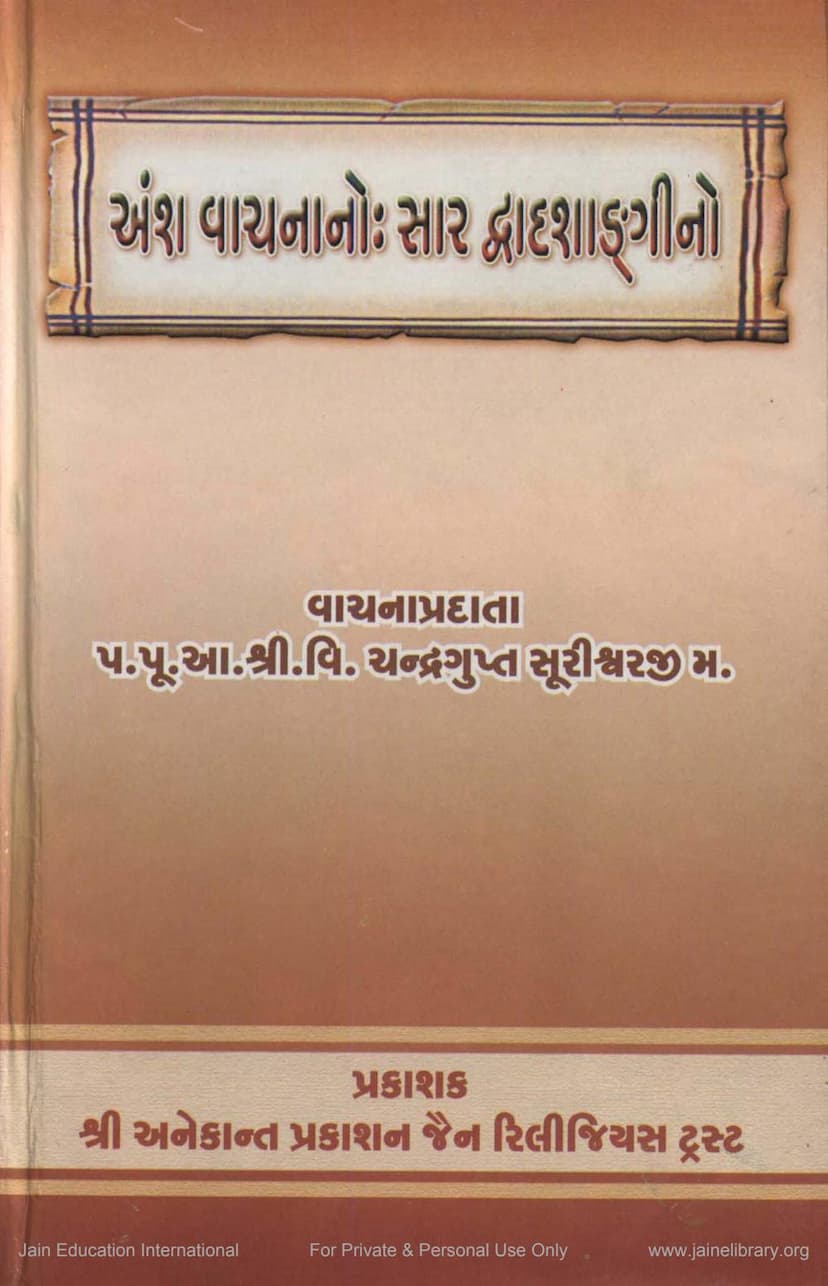Ansh Vachnano Sara Dvadashangino 1
Added to library: September 1, 2025

Summary
The book "Ansh Vachnano Sara Dvadashangino 1" by Acharya Chandraguptasuri, published by Shri Anekant Prakashan Jain Religious Trust, is a profound discourse on the essence of Jain spiritual practice, particularly focusing on the characteristics of an ideal monk, referred to as a "Bhav Sadhu" (a monk of true spiritual inclination). The text draws heavily from the "Dharmaratna Prakaran" by Acharya Shantrisurishwarji Maharaj, which elaborates on twenty-one qualities for attaining the jewel of Dharma, seventeen characteristics of a devoted layman, and seven qualities of a Bhav Sadhu for attaining the path of monasticism.
The central theme of the book is to delineate the "linga" or characteristics that define a true Bhav Sadhu, contrasting them with the superficialities of mere outward observance. The author, Acharya Chandraguptasuri, emphasizes that true adherence to Jain principles lies in internal transformation and consistent practice rather than mere adherence to rituals or external appearances.
The book begins by highlighting the significance of the diksha kalyanak (initiation ceremony) of the Tirthankaras, underscoring that even Tirthankaras attained their exalted state after renouncing the world and embracing the path of a monk. This sets the stage for the detailed discussion on the qualities of a true monk.
The core of the book is a detailed explanation of the seven characteristics (linga) of a Bhav Sadhu, which are presented as essential for spiritual progress and ultimately, for achieving liberation (moksha). These seven characteristics are:
-
Marganusari Kriya (Actions in accordance with the path): This emphasizes that all actions of a monk must be aligned with the spiritual path leading to moksha, as prescribed by the scriptures and enlightened beings. It's about following the true "marg" (path) that leads to liberation, not just engaging in activities. The author clarifies that the path is defined by the teachings of the Tirthankaras and the conduct of virtuous monks.
-
Shraddha (Faith/Devotion): True Shraddha is described not merely as belief but as an intense, unwavering desire and effort to attain the spiritual goal (moksha) through righteous conduct (charitra). It's a deep-seated aspiration that fuels all spiritual endeavors. The text highlights that this Shraddha is characterized by:
- Vidhi-purva Seva (Service performed with adherence to proper procedure): This stresses the importance of performing rituals and duties with utmost care and adherence to prescribed methods, involving purity of substance, place, time, and intention.
- Atrupti (Unquenchable desire for spiritual growth): This refers to a continuous striving for improvement, never being satisfied with the current level of spiritual attainment, and always aspiring for further progress.
- Shuddha Deshna (Pure preaching/guidance): True spiritual guidance should be based on the scriptures, free from personal biases or ulterior motives, and aimed at the welfare of the listener. It must be delivered by those who have themselves attained a deep understanding of the path and have the authority to guide others.
- Skhalita Parishuddhi (Purification of lapses): This involves acknowledging and rectifying any spiritual shortcomings or transgressions with sincere repentance and a firm resolve not to repeat them. It's about maintaining the purity of one's conduct.
-
Pradnyapaniyata (Amenability to proper guidance/Receptiveness to truth): This quality signifies an open mind and a willingness to learn and accept correct teachings. A true monk, even with deep knowledge, remains receptive to correction and guidance from a true guru, understanding that even enlightened beings have a hierarchical relationship with their teachers. It's about being teachable and avoiding self-conceit.
-
Kriya mein Apramad (Vigilance in actions): This highlights the absolute necessity of remaining alert and diligent in all spiritual practices. It's about avoiding complacency and actively striving for progress, understanding that even a moment's lapse in vigilance can lead to downfall. The text elaborates on five types of negligence: intoxicants, indulgence in senses, indulgence in passions, excessive sleep, and idle talk.
-
Shakya Anushthan ka Arambh (Initiation of achievable practices): This emphasizes the importance of undertaking practices that are within one's capacity, without overestimating or underestimating oneself. It's about performing actions according to one's strength and potential, while also striving to increase that capacity through dedicated effort. It's about making a realistic and consistent effort towards spiritual goals.
-
Gunanurag (Appreciation of virtues): This signifies a deep appreciation for the virtues of others, even those who may seem inferior. It's about recognizing and valuing the good qualities in everyone, fostering humility and avoiding the tendency to criticize or belittle others. True appreciation for virtues is a stepping stone to acquiring them oneself.
-
Guru Aradhana (Adherence to the guru's command): This is presented as the culmination and foundation of all other qualities. The absolute obedience and devotion to the guru's commands, even if they seem difficult, is crucial. However, this obedience is within the framework of the true path and the teachings of the Tirthankaras. If a guru deviates from the path, then even their guidance should be scrutinized with scriptures as the ultimate authority.
Throughout the text, the author draws upon numerous examples and anecdotes from Jain scriptures and the lives of great saints and kings to illustrate the practical application of these principles. The book serves as a guide for both ascetics and lay followers, urging them to look beyond outward rituals and focus on cultivating inner virtues and a genuine aspiration for spiritual liberation. It highlights the paramount importance of the guru-disciple relationship and the need for unwavering faith in the teachings of the Tirthankaras. The underlying message is a call to authentic spiritual practice, emphasizing sincerity, diligence, and a profound aspiration for moksha.